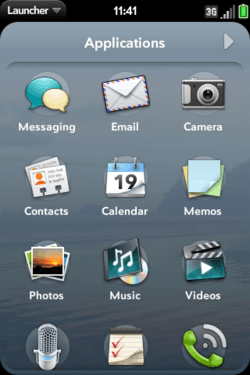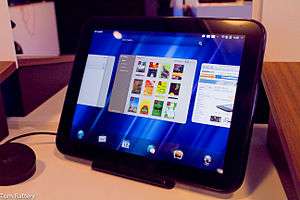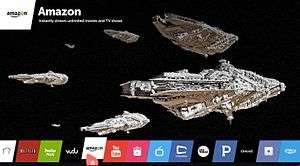WebOS
|
| |
|
WebOS running on an LG Smart TV | |
| Developer |
LG Electronics, Open WebOS community contributors, previously Hewlett-Packard & Palm |
|---|---|
| Written in | C++, Qt[1] |
| OS family | WebOS (based on Linux kernel) |
| Source model | Open source |
| Latest release |
3.0.5 (tablet) |
| Marketing target | Embedded devices |
| Available in | English (US), Spanish, French, Italian and German |
| Platforms | ARM |
| Kernel type | Monolithic (Linux kernel) |
| Default user interface | Graphical (Luna) |
| License | Apache License |
| Official website |
www |
WebOS, also known as Open WebOS or LG WebOS, (previously known as HP WebOS and Palm WebOS, stylized as webOS)[2] is a Linux kernel-based multitask operating system for smart devices like TVs and smartwatches. It was formerly a mobile operating system. Initially developed by Palm (which was acquired by Hewlett-Packard), HP made the platform open source, at which point it became Open WebOS. The operating system was later sold to LG Electronics. HP still held many patents related to WebOS. In January 2014, Qualcomm has announced that it has acquired technology patents from HP, which includes all the WebOS patents.[3]
Various versions of WebOS have been featured on several devices, including Pre, Pixi, and Veer smartphones, TouchPad tablet, LG Smart TVs since 2015, and smartwatches including LG Watch Urbane LTE and the Audi smartwatch.[4]
History
Palm
Palm launched WebOS, then called Palm WebOS, in January 2009 as the successor to Palm OS. The first WebOS device was the original Palm Pre, released by Sprint in June 2009. The Palm Pixi followed. Upgraded "Plus" versions of both Pre and Pixi were released on Verizon and AT&T.
HP
In April 2010 HP acquired Palm; WebOS was described by Leo Apotheker as a key asset and motivation for the purchase. The $1.2 billion acquisition finalized in June. HP indicated its intention to develop the WebOS platform for use in multiple new products, including smartphones, tablets, and printers.[5]
In February 2011, HP announced that it would use WebOS as the universal platform for all its devices.[6] However, HP also made the decision[7] that the Palm Pre, Palm Pixi, and the "Plus" revisions would not receive over-the-air updates to WebOS 2.0,[8] despite a previous commitment to an upgrade "in coming months."[9] HP announced several WebOS devices, including the HP Veer and HP Pre 3 smartphones, running WebOS 2.2, and the HP TouchPad, a tablet computer released in July 2011 that runs WebOS 3.0.
In March 2011 HP announced plans for a version of WebOS by the end of 2011 to run within Windows,[10] and to be installed on all HP desktop and notebook computers in 2012.[11] Neither ever materialized, although work had begun on an x86 port around this time involving a team in Fort Collins, Colorado; work was scrapped later in the year.
In August 2011 HP announced that it was interested in selling its Personal Systems Group, responsible for all of its consumer PC products, including WebOS, and that WebOS device development and production lines would be halted.[12][13][14] It remained unclear whether HP would consider licensing WebOS software to other manufacturers. When HP reduced the price of the Touchpad to $99, the existing inventory quickly sold out.[15]
The HP Pre 3 was launched in select areas of Europe, and US-based units were available only through unofficial channels (both AT&T and Verizon canceled their orders just prior to delivery after Apotheker's (HP's CEO at the time) announcement.[16] Notably, these US Pre 3 units, having been released through unofficial channels, lacked both warranties and carried no support obligation from HP; as a result parts are nearly impossible to come by. HP announced that it would continue to issue updates for the HP Veer and HP TouchPad, but these updates have failed to materialize for the former, and the latter saw a final, unofficial release called "WebOS CE" that contained only open-sourced components of WebOS meant for what remained of the developer community rather than a conventional, user-centric update to the operating system. The last HP WebOS version, 3.0.5, was released on 12 January 2012.
In December 2011, after abandoning the TouchPad and the proposed sale of the HP Personal Systems Group, HP announced it would release WebOS source code in the near future under an open-source license.[17] In August 2012, code specific to the existing devices was released as WebOS Community Edition (CE), with support for the existing HP hardware.[18] Open WebOS includes open source libraries designed to target a wider range of hardware. HP renamed its WebOS unit as "Gram".[19][20]
In February 2012 HP released Isis, a new web browser for Open WebOS.[21]
Growth and decline of HP App Catalog

The HP App Catalog was an app store for apps for the mobile devices running WebOS.
On 6 June 2009, WebOS launched on the Palm Pre with 18 available apps. The number of apps grew to 30 by 17 June 2009,[22] with 1 million cumulative downloads by 27 June 2009;[23] 30 official and 31 unofficial apps by 13 July 2009;[24] 1,000 official apps by 1 January 2010;[25] 4,000 official apps 29 September 2010;[26] and 10,002 official apps on 9 December 2011.[27]
Subsequently, the number of available apps has decreased because many apps have been pulled from the App Catalog from its owners. Examples include the apps for The New York Times and Pandora Radio. The number of remaining functional apps was unknown. When factoring out abandoned and/or non-functioning apps that remain in the App Catalog at present, the number is projected to be substantially lower. WebOS users lost HP App Catalog access after the 15 March 2015 shutdown of the HP App Catalog servers; this was notified by a Catalog splash screen on 11 November 2014.[28]
LG
On 25 February 2013, HP announced that it was licensing WebOS to LG Electronics for use on its web-enabled smart TVs. Under the agreement LG Electronics is allowed unlimited access to the documentation, source code, developers and all related websites. LG Electronics licensed WebOS from HP to enhance its smart TVs, replacing its previous NetCast platform.[29][30] However, HP will still hold on to patents underlying WebOS as well as cloud-based services such as the App Catalog.[31] As well as its use as an OS for smart TVs, LG has expanded its use to various IoT devices. As a starting point, LG showcased an LG Wearable Platform OS (WebOS) smartwatch in early 2015.[32]

Features

The WebOS mobile platform introduced some innovative features, such as the cards interface, that are still in use by Apple, Microsoft and Google on their mobile operating systems iOS, Windows Phone, and Android, respectively.
| Feature | LG WebOS | Open WebOS | HP/Palm WebOS |
|---|---|---|---|
| Multitasking interface | Line cards | Cards | Cards |
| Gesture interface | Magic Remote | touch screen physical keyboard |
touch screen physical keyboard |
| Synergy | No | No | Yes |
| App store | LG Store | No | HP App Catalog |
| Over-the-air updates | Yes | Yes | Yes |
| Wireless recharging | ? | ? | Yes |
| Service discovery | Connect SDK | No | ZeroConf / Touch to Share |
| Open source | No | Yes | Partial[33] |
| Devices |
|
Multitasking interface
Navigation uses multi-touch gestures on the touchscreen. The interface uses "cards" to manage multitasking and represent apps. The user switches between running apps with a flick from left and right on the screen. Apps are closed by flicking a "card" up—and "off"—the screen. The app "cards" can be rearranged for organization. WebOS 2.0 introduced 'stacks', where related cards could be "stacked" together.

Synergy
Palm referred to integration of information from many sources as "Synergy." Users can sign into multiple email accounts from different providers and integrate all of these sources into a single list. Similar capabilities pull together calendars and also instant messages and SMS text messages from multiple sources.[39]
Over-the-air updates
The OS can be updated without docking to a PC, instead receiving OS updates over the carrier connection.
Notifications
The notification area is located on the bottom portion of the screen on phones, and on the top status bar area on tablets.
On phones, when a notification comes in, it slides in from the bottom of the screen. Due to the resizable nature of the Mojo and Enyo application frameworks, the app usually resizes itself to allow unhindered use while the notification is displayed. After the notification slides away, it usually remains as an icon. The user can then tap on the icons to expand them. Notifications can then be dismissed (sliding off the screen), acted upon (tapping), or left alone.
Sync
By default, data sync uses a cloud-based approach rather than using a desktop sync client. The first version of WebOS shipped with the ability to sync with Apple's iTunes software by masquerading as an Apple device, but this feature was disabled by subsequent iTunes software updates.
Third-party applications
On HP WebOS, officially vetted third-party apps are accessible to be installed on the device from the HP App Catalog.[40]
As HP WebOS replaced Palm OS, Palm commissioned MotionApps to code and develop an emulator called Classic, to enable backward compatibility to Palm OS apps. This operates with WebOS version 1.0. Palm OS emulation was discontinued in WebOS version 2.0.[41] MotionApps disengaged from Classic in 2010, citing HP Palm as "disruptive."[42]
Another source of applications is homebrew software.[43][44] Homebrew apps are not directly supported by HP. Programs used to distribute homebrew WebOS apps include WebOS Quick Install (Java-based for Desktop computers), and Preware (a homebrew WebOS app catalog, which must be sideloaded to install). If software problems do occur after installing homebrew programs, "WebOS Doctor" (provided by HP) can restore a phone back to factory settings and remove changes made by homebrew apps and patches.[45]
Smart TV features
LG has redesigned the UI of WebOS, whilst maintaining the card UI as a feature called "Simple switching" between the TV apps. The other two features promoted by the company are simple connection (using an animated Clippy-like character called Beanbird to aid the user through setup), and simple discovery.
Platform
Underneath the graphical user interface, WebOS has much in common with mainstream Linux distributions. Versions 1.0 to 2.1 use a patched Linux 2.6.24 kernel.[46]
The list of open-source components used by the different releases of WebOS, as well as the source code of and patches applied to each component, is available at the Palm Open Source webpage.[46] This page also serves as a reference listing of the versions of WebOS that have been publicly released.
In 2011, Enyo replaced Mojo, released in June 2009, as the software development kit (SDK).[47]
Hardware
Phones
Tablets
- HP TouchPad
- HP TouchPad Go
Televisions
- Some LG Smart TV models[37]
Watch
See also
Notes
References
- ↑ "QtWS15- Bringing LG webOs and Qt to millions of smartTVs".
- ↑ "HP webOS Developer FAQ". Palm, Inc.
- ↑ Qualcomm purchases Palm patents from HP USA Today January 24, 2014. Retrieved February 22, 2016
- ↑ "Exclusive: The LG Audi smartwatch runs webOS!". 7 January 2015. Retrieved 8 January 2015.
- ↑ Bajarin, Ben (30 June 2011). "HP Is Committed to Its 'WebOS' Platform (and It Should Be).". Time. TechLand. Time Inc. Retrieved 27 November 2013.
- ↑ "HP snubs Windows, plans to integrate WebOS into PCs". Digital Trends. 9 February 2011. Retrieved 14 June 2013.
- ↑ "Thanks (really!) for the feedback". Hewlett Packard.
- ↑ "HP Breaks Promise: WebOS 2.0 Upgrades for Palm Pre and Pixi Not Coming". Brighthand.com. Retrieved 13 February 2011.
- ↑ Hardy, Ed (20 November 2010). "HP Commits to WebOS 2.0 Upgrades for All Palm Smartphones". Brighthand.com. Retrieved 27 November 2013.
- ↑ Hollister, Sean (14 March 2011). "HP TouchPad coming June, WebOS for PC beta by year's end". Engadget. AOL Inc. Retrieved 27 November 2013.
- ↑ "Apotheker Seeks to Save HP's 'Lost Soul' With Software Growth". BusinessWeek. Bloomberg L.P. 9 March 2011. Retrieved 9 March 2011.
- ↑ "Developing and Distributing with HP: Developer Program Details". palm.com. Hewlett-Packard Development Company. 2010. Archived from the original on 2010-12-01.
- ↑ "HP Confirms Discussions with Autonomy Corporation plc Regarding Possible Business Combination; Makes Other Announcements". Press release. 18 August 2011. Retrieved 18 August 2011.
- ↑ "HP kills WebOS, spins off PC business to focus on software". AppleInsider. 11 August 2011. Retrieved 18 August 2011.
- ↑ "HP Web OS -High connectivity, stability and security". Hewlett-Packard. Retrieved 10 March 2011.
- ↑ Fried, Ina (22 August 2011). "HP: WebOS Still Coming to PCs and Printers, Pre3 Launching in "Limited" Markets". AllThingsD. Dow Jones & Company. Retrieved 24 August 2011.
- ↑ "HP to Contribute WebOS to Open Source". HP.com (Press release). Hewlett-Packard. 9 December 2011. Retrieved 10 December 2011.
- ↑ Paul, Ryan (August 3, 2012). "HP releases more Open WebOS code, including System Manager and core apps". arstechnica.com.
- ↑ Hesseldahl, Arik (15 August 2012). "Meet Gram, HP's New Name for the Company Formerly Known as Palm". All Things D. Retrieved 17 August 2012.
- ↑ Musil, Steven (15 August 2012). "HP spins off WebOS business, rebranding it as 'Gram'". CNET. CBS Interactive. Retrieved 5 December 2012.
- ↑ Kessler, Derek (2012-02-14). "HP releases Open WebOS' new browser Isis, JavaScript core, and Enyo UI widgets 34". Retrieved 2015-04-20.
- ↑ Barletta, Bryan (18 June 2009). "Palm Pre Prepared For The Spotlight?". Medialets, Inc.
- ↑ Barletta, Bryan (24 June 2009). "Palm Pre App Catalog Reaches 1 Million Downloads". Medialets, Inc.
- ↑ Bohn, Dieter (10 July 2009). "Palm Pre Homebrew: 31 Apps. Official App Catalog: 30". PreCentral.net. Smartphone Experts.
- ↑ Werlinger, Robert (1 January 2010). "App Catalog Hits 1000 apps". WebOS Nation. Retrieved 27 April 2012.
- ↑ Bohn, Dieter (29 September 2010). "WebOS surpasses 5,000 apps". WebOS Nation. Retrieved 27 April 2012.
- ↑ Touchpad breaks 1,000 app milestone. WebOSNation.com, 9 December 2011.
- ↑ Pre to postmortem: the inside story of the death of Palm and WebOS
- ↑ "Gram working with LG on an Open webOS TV". webOS Nation. 24 October 2012.
- ↑ "LG Electronics Acquires WebOS from HP to Enhance Smart TV". Press Release: February 25, 2013. Hewlett-Packard. 25 February 2013. Retrieved 14 June 2013.
- ↑ "HP offloads Palm WebOS assets to Korea's LG". BBC News. Retrieved 26 February 2013.
- ↑ Patel, Nilay (25 February 2013). "HP emerges as big winner in WebOS sale". The Verge. Vox Media. Retrieved 6 January 2014.
- ↑ "Open Source Packages". Retrieved 6 April 2014.
- 1 2 Byford, Sam (1 March 2015). "Our first look at LG's new webOS and Android Wear smartwatches". The Verge. Retrieved 2016-08-28.
- 1 2 Benson, Matthew (23 June 2015). "Watch Urbane LTE impressions: LG's little known WebOS experiment". Android Authority. Retrieved 2016-08-28.
- 1 2 Reed, Brad (5 March 2015). "I can't believe I'm saying this but… webOS looks like a great smartwatch platform". BGR. Retrieved 2016-08-28.
- 1 2 "LG WebOS TV Smart+". LG.com. LG Corporation. Retrieved 2016-08-28.
- ↑ "Devices". WebOS Ports. Retrieved 2016-08-28.
- ↑ "Palm Unveils All-new WebOS" (Press release). Palm, Inc. 8 January 2009. Retrieved 27 May 2009.
- ↑ "HP webOS official website". Palm, Inc. Retrieved 14 June 2013.
- ↑ Derek Kessler. 25 Oct. 2010.WebOS 2.0, MotionApps drops Classic PalmOS Emulator in Palm's lap.
- ↑ MotionApps. 25 Oct. 2010.Classic's Got a Brand New Home! MotionApps Hands Classic Over to Palm
- ↑ Precentral (precentral.net). Homebrew Apps
- ↑ milominderbinder (precentral.net) 22 Jan. 2010. Getting Started: Homebrew Apps, Patches, and Themes with WebOS Quick Install.
- ↑ "HP WebOS Doctor". HPWebOS.com. Retrieved 6 January 2014.
- 1 2 "Open Source Packages: HP webOS open source compliance". openwebosproject.org. Retrieved 28 October 2013.
- ↑ Jesse Mendoza (30 March 2010). "HP Rolls Out WebOS 3.0 Beta with Enyo On Board".
External links
| Wikimedia Commons has media related to WebOS. |
